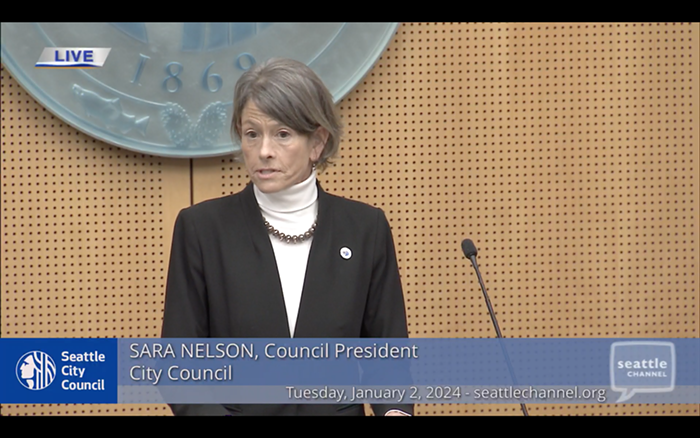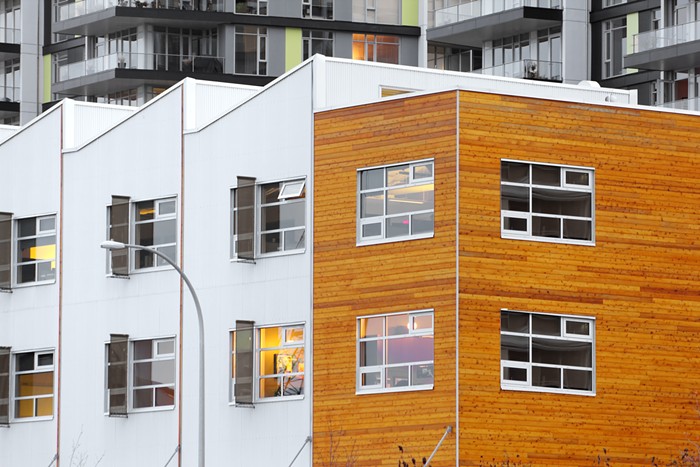Seattle is a city of houses; some 80 percent of our land is zoned for detached, single-family homes, and that land is built out to its limits. Outside our downtown core, we enforce strict height limits that are intended to give even our bustling neighborhood commercial streets a low-rise, small-town Main Street character. New buildings on most of these streets can be no higher than 40 feet. We aggressively defend our views of the water and the mountains, views no neighborhood group has ever willingly traded for the side of a concrete and glass highrise. But if trends of the past decade continue, we're going to grow as a city, and we thus need to build. If we don't want to build out, creating sprawl, we're going to have to build up and pack more people into existing buildings, creating density.
Seattle rents are high--growing faster than inflation for the entire second half of the '90s--for one simple reason, lit like a neon sign that says "No Vacancy": The entire city's like a Holiday Inn during a neverending convention weekend.
The current vacancy rate in Puget Sound's five counties as of April 2000 was 4.1 percent. In Seattle's neighborhoods, the figures can strain credulity: 1.6 percent in Ballard, 0.2 percent in Madison Park/Leschi, 1.9 percent in Capitol Hill/Eastlake, 2.8 percent in North Seattle, 2.9 percent downtown (including Belltown), and 1 percent in the University District. Mike Scott of Dupre + Scott Apartment Advisors (which compiles vacancy figures twice a year) says the equilibrium vacancy rate for Seattle--where rents would achieve stasis--is a little over four percent. Go over that, and landlords won't be able to raise rents at the rate of inflation; go under that, as we have since about 1996, and rents will outpace inflation. Vacancy rates could rise in two ways: People could leave the rental market or new units could open faster than renters enter the market.
Among Council Member Judy Nicastro's six proposals to better the lot of Seattle's renter population are two big ideas that would directly impact our vacancy rate: encouraging the development of new housing units in Seattle's residential neighborhoods, and lobbying Olympia to repeal the statewide ban against rent regulation. Unfortunately, Nicastro's two proposals are in direct conflict with each other, and if both were enacted, they would likely cancel each other out. Increased rental development would help address Seattle's housing shortage, bringing supply in line with demand and flattening rents. Rent control, however, would suppress new development, furthering the supply-side imbalance and making rents for tenants in non-rent-controlled apartments much more costly. The prospect of Olympia allowing Washington's cities to impose rent control is unlikely, however, so let's focus on supply.
The market has already begun ramping up, with 3,300 units added in King County in 1999. About the same number are expected to enter the market in 2000; 3,400 are planned for 2001, and 5,700 for 2002 (given the length of time it takes to plan and construct a new building, the number of units actually completed by 2002 will probably be 20 to 40 percent lower than projected). As of yet, the production of new units hasn't raised the vacancy rate and rents continue to rise, but the tide may be shifting in favor of renters. Real estate is cyclical in Seattle, with binges of construction (as in the early '90s) followed by droughts (the mid-'90s). It can take three or four years for a planned project to move from conception to completion, so the supply side has a hard time keeping pace with demand. The result is a sine wave of periods of overbuilding alternating with underbuilding.
That doesn't mean we can't goose the process by promoting faster growth and shortening the vacancy sine wave's cycle. A faster permitting process at the DCLU, which currently can take a year and a half to issue a permit, would help immeasurably.
John Kucher, a local developer, suggests reforming the zoning code governing apartment construction. He'd start with a problem that was introduced into the city's zoning ordinance in 1988. Where earlier laws had mostly regulated the size of buildings, leaving it to developers to decide how to divvy up the space inside, the 1988 change limited the number of units that could be built based on the square footage of the plot. Kucher says he could fit 18 studios or "open-floor-plan one bedrooms" in a 60' by 120' site, but under current code, he's limited to nine larger, more expensive units. A reform of the code would allow more flexibility and variety in development, and add more units in new and rehabbed buildings in Seattle without increasing the size of buildings.
But zoning, as it turns out, isn't the only problem. Developers at the very high and low ends of the income spectrum have been handed new tools in the last few years that they haven't fully capitalized on. The first, transfers of development rights, or TDRs, allows developers in a few areas of town, like the Denny Triangle, to build higher. This enables developers to add stories to highrises in the Triangle, while preserving open space or low-rise buildings elsewhere. Richard Stevenson of Clise Properties, an active player in the TDR market, says, "There's not much of a market for TDRs." The city should further promote this program, which can have the added benefits of preserving forests and farmland, funding open space in the city, and boosting revenues of downtown arts institutions in low-rise buildings.
On a micro-scale, the city is flirting with density in the neighborhoods, liberalizing the laws regulating "mother-in-law apartments" (basements, attics, rooms over garages), and allowing developers to build trial multi-home projects like cottages, duplexes, and row houses in single-family house neighborhoods. According to Mike Luis of the nonprofit Housing Partnership, only a few hundred new "accessory dwelling units" (political speak for mother-in-laws) have been added since the city liberalized its laws regulating them in 1995. This is a huge potential market, especially for home-owning seniors on fixed incomes, but adding new supply depends on the interest level of individual homeowners. They're cheaper than new apartments, according to Luis, but the financing and construction can seem daunting to non-professionals. It's a lucrative new industry waiting to happen, he adds, for some bold entrepreneur willing to scour the city for conversion opportunities, but it may take a while for the market to materialize.
Down the line, Seattle will probably have to consider serious density--view-blocking buildings and all--but for now, we may be able to achieve the kind of slow growth Seattleites favor and still work toward bringing rents within the average person's reach. We can build our way out of the problem without radically redefining Seattle's classic not-too-hot/not-too-cold self-image. But we have to build. *


















